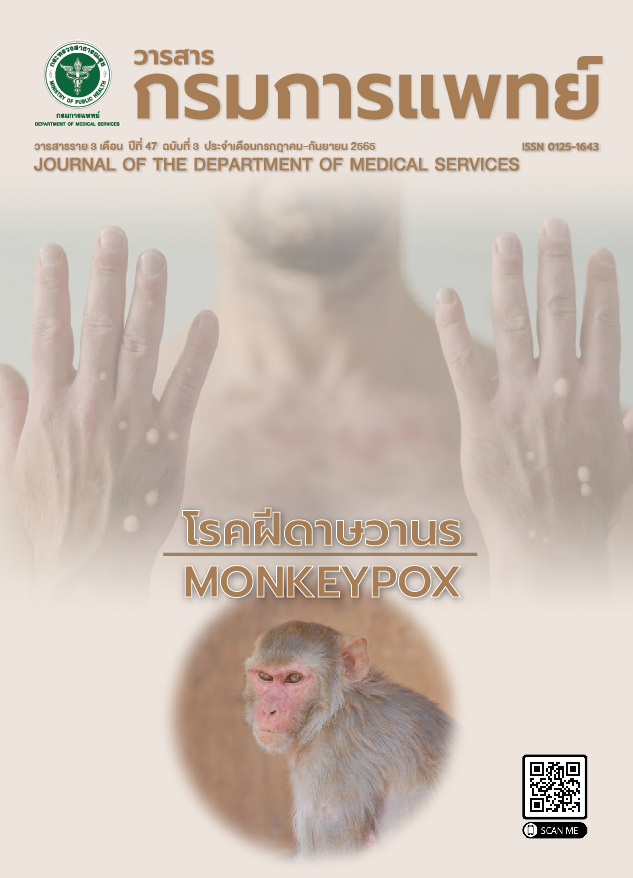Factors Associated with Peptic Ulcer Disease in Buddhist Monks at Priest Hospital from the Case-control Study
Keywords:
Peptic ulcer disease, Monks, H.pyloriAbstract
Background: Peptic ulcer disease (PUD) embraces both gastric and duodenal ulcers. PUD is a source of significant morbidity and mortality worldwide. The predominant symptom of PUD is epigastric pain but some patients are asymptomatic. The causes of PUD are multifactorial. Buddhist monks who practice religious asceticism by monastic living, abbot environment and one or twice eating before mid-day. The previous studies found different risk factors of PUD. However, nearly total of studies were conducted among laity. Objective: To identify the factors associated with PUD in Thai monks. Methods: A case-control study was conducted among monks who underwent esophagogastroduodenoscopy (EGD) from 1st September 2018 to 31st October 2021 at Department of Medicine, Priest Hospital. From 215 monks, after exclusion criteria, 179 monks were included. The statistics was used by binary logistic regression for identifying risk factors of PUD. Results: Total of 179 monks were enrolled in this study. The median age was 63 years old (ranged 22-88). In all, 72 monks (40.2%) had PUD. The prevalence of H. pylori infection was 44.7% (80 of 179 monks). The factors associated with PUD were statistically significant in tobacco smoking (adjusted OR 7.40, 95% CI: 2.99, 18.29), prior history of PUD (adjusted OR 8.94, 95% CI: 2.11, 37.76) and H. pylori infection (adjusted OR 4.20, 95% CI: 1.88, 9.42). However, PUD was not significantly associated with age, intake of nonsteroidal anti-inflammatory drugs (NSAIDS), number of meals per day or duration of ordination. Conclusion: Tobacco smoking, prior history of PUD and H. pylori infection are the factors associated with PUD in Buddhist monks at Priest Hospital. Nonetheless, the Buddhist priests way of living is not a risk factor causing PUD.
References
Sung JJ, Kuipers EJ, El-Serag HB. Systematic review: the global incidence and prevalence of peptic ulcer disease. Aliment Pharmacol Ther. 2009; 29: 938-46.
Wilairatana S, Kladchareon N, Israsena S, Wilairatana P. Epidemiology of peptic ulcer disease in Thailand. Gastroenterol Jpn. 1991; 26: 265-6.
Li Z, Zou D, Ma X, Chen J, Shi X, Gong Y, et al. Epidemiology of peptic ulcer disease: endoscopic results of the systematic investigation of gastrointestinal disease in China. Am J Gastroenterol. 2010; 105: 2570-7.
Galbán E, Arús E, Periles U. Endoscopic findings and associated risk factors in primary health care settings in Havana, Cuba. MEDICC Rev. 2012; 14: 30-7.
Barazandeh F, Yazdanbod A, Pourfarzi F, Sepanlou SG, Derakhshan MH, Malekzadeh R. Epidemiology of peptic ulcer disease: endoscopic results of a systematic investigation in iran. Middle East J Dig Dis. 2012; 4: 90-6.
Rosenstock S, Jørgensen T, Bonnevie O, Andersen L. Risk factors for peptic ulcer disease: a population based prospective cohort study comprising 2416 Danish adults. Gut. 2003; 52: 186-93.
Huang JQ, Sridhar S, Hunt RH. Role of Helicobacter pylori infection and non-steroidal anti-inflammatory drugs in peptic-ulcer disease: a meta-analysis. Lancet 2002; 359: 14-22.
Archampong TN, Asmah RH, Wiredu EK, Gyasi RK, Nkrumah KN. Factors associated with gastro-duodenal disease in patients undergoing upper GI endoscopy at the Korle-Bu Teaching Hospital, Accra, Ghana. Afr Health Sc. 2016; 16: 611-9.
Garrow D, Delegge MH. Risk factors for gastrointestinal ulcer disease in the US population. Dig Dis Sci. 2010; 55: 66-72.
Wang FW, Tu MS, Mar GY, Chuang HY, Yu HC, Cheng LC, et al. Prevalence and risk factors of asymptomatic peptic ulcer disease in Taiwan. World J Gastroenterol 2011; 17: 1199-203.
Kavitt RT, Lipowska AM, Anyane-Yeboa A, Gralnek IM. Diagnosis and Treatment of Peptic Ulcer Disease. Am J Med. 2019; 132: 447-56.
Tantiwattanasirikul P. Peptic ulcer disease in Priest Hospital. J Med Assoc Thai 2008; 91: S53-6.
Li LF, Chan RL, Lu L, Shen J, Zhang L, Wu WK, et al. Cigarette smoking and gastrointestinal diseases: the causal relationship and underlying molecular mechanisms (review). Int J Mol Med. 2014; 34: 372-80.
Lau JY, Sung J, Hill C, Henderson C, Howden CW, Metz DC. Systematic review of the epidemiology of complicated peptic ulcer disease: incidence, recurrence, risk factors and mortality. Digestion. 2011; 84: 102-13.
Wang AY, Peura DA. The prevalence and incidence of Helicobacter pylori-associated peptic ulcer disease and upper gastrointestinal bleeding throughout the world. Gastrointest Endosc Clin N Am 2011; 21: 613-35.
Lee SP, Sung IK, Kim JH, Lee SY, Park HS, Shim CS. Risk Factors for the Presence of Symptoms in Peptic Ulcer Disease. Clin Endosc. 2017; 50: 578-84.
Eloumou Bagnaka SA, Luma Namme H, Noah Noah D, Essomba NE, Malongue A, Manga A, et al. Risk factors associated with gastroduodenal lesions in a Douala referral hospital (Cameroon). Med Sante Trop. 2016; 26: 104-9.
Dib RA, Chinzon D, Fontes LH, de Sa Teixeira AC, Navarro-Rodriguez T. Ulcer and bleeding complications and their relationship with dyspeptic symptoms in NSAIDs users: a transversal multicenter study. Scand J Gastroenterol. 2014; 49: 785-9.
Zhang W, Liang X, Chen X, Ge Z, Lu H. Time trends in the prevalence of Helicobacter pylori infection in patients with peptic ulcer disease: a single-center retrospective study in Shanghai. J Int Med Res. 2021; 49.
Dong WG, Cheng CS, Liu SP, Yu JP. Epidemiology of peptic ulcer disease in Wuhan area of China from 1997 to 2002. World J Gastroenterol. 2004; 10: 3377-9.
Chomvarin C, Kulsuntiwong P, Mairiang P, Sangchan A, Kulabkhow C, Chau-in S, et al. Detection of H. pylori in dyspeptic patients and correlation with clinical outcomes. Southeast Asian J Trop Med Public Health. 2005; 36: 917-22.
Sirinthornpunya S. Prevalence of Helicobacter pylori infection in patients with peptic disease. J Med Assoc Thai. 2012; 95: S22-7.
Shoosanglertwijit R, Kamrat N, Werawatganon D, Chatsuwan T, Chaithongrat S, Rerknimitr R. Real-world data of Helicobacter pylori prevalence, eradication regimens, and antibiotic resistance in Thailand, 2013-2018. JGH Open. 2020; 4: 49-53.
Downloads
Published
How to Cite
Issue
Section
License
Copyright (c) 2022 Department of Medical Services, Ministry of Public Health

This work is licensed under a Creative Commons Attribution-NonCommercial-NoDerivatives 4.0 International License.
บทความที่ได้รับการตีพิมพ์เป็นลิขสิทธิ์ของกรมการแพทย์ กระทรวงสาธารณสุข
ข้อความและข้อคิดเห็นต่างๆ เป็นของผู้เขียนบทความ ไม่ใช่ความเห็นของกองบรรณาธิการหรือของวารสารกรมการแพทย์



